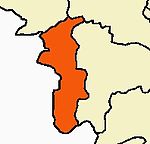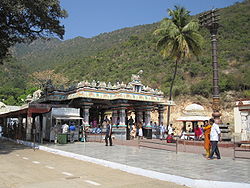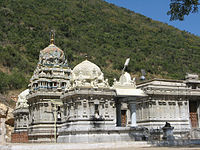- Marudamalai
-
Marudamalai Coordinates: 11°2′46″N 76°51′7″E / 11.04611°N 76.85194°ECoordinates: 11°2′46″N 76°51′7″E / 11.04611°N 76.85194°E Name Proper name: Marudamalai Murugan Temple Location Country: India State: Tamil Nadu Location: Coimbatore Architecture and culture Primary deity: Murugan Architectural styles: Dravidian architecture History Date built:
(Current structure)unknown Website: marudhamalaitemple.info Marudamalai is a popular temple of the Hindu god Murugan, situated top a hill of the same name in Coimbatore, Tamil Nadu, India. Of all the temples of Murugan it is next only in importance to the Arupadaiveedu temples ("The six Fort-Houses of Muruga"), for the god's devotees. Some people consider Marudhamalai to be the unofficial seventh Padaiveedu of Muruga, along with a few other contenders for the spot, including Kunrakudy, Sikkal and Vayalur.
Like most Murugan temples, Marudhamalai Murugan temple is situated upon a hill that is a part of the Western Ghats and is about 15 km west from the city of Coimbatore.
This is an ancient temple. References to this temple are found in inscriptions in the Thirumuruganpoondi temple. Thirumuruganpoondi temple is a "Tevarapaadalpetrastalam" and is at least 1200 years old. So we can surmise that the Marudhamalai temple is older than 1200 years.
There is a shrine called the "Paambaatti Sitthar Kugai" (Paambaatti Sitthar cave) that is in proximity to the Murugan temple. Legend has it that a Sitthar referred to as the Paambaatti Sitthar lived here in Marudhamalai. Paambaatti Sitthar is one of the most notable 18 Sitthars. Pambaatti Sitthar as his name indicates that he was associated with snake charming. As is the custom of the Sitthars of Tamil Nadu, he too, in the interest of mankind, has written extensively on the medicinal values and applications of plants.
Near the foothills, there is a temple for Lord Pillayar who is known as the "Thaanthondri Vinaayakar" (which means that the Pillayar idol appeared on its own without human intervention.)
This temple is under the control of Religious endowments department of Government of Tamil Nadu
This temple is located on a hilltop called Marudha Malai (roughly translating to "hill of vegetation"), true to its name, the legend has it that this hill has many herbs of medicinal value. The hill is also home to a particular sect of tribal tamil people. The temple in recent years has been renovated and the local business community is supporting this activity. The temple also plans to have a rope car operate from the foothills. In recent years number of Nature cure clinics have come up nearby this hillside.
Murugan temples Palani · Thiruchendur · Swamimalai · Thiruthani · Pazhamudircholai · Thiruparamkunram · Subramanya · Marudamalai · Chennimalai · Thindalmalai · Sikkal · Vayalur · Viralimalai · Kunrakudy · Malai Mandir · Nallur · Maviddapuram · Batu Caves · Brickfields · KathirkamamCoimbatore district District Headquarters  -->
-->Country State Region Taluks Blocks Anamalai · Annur · Karamadai · Kinathukadavu · Madukkarai · Periyanayakkanpalayam · Pollachi(North) · Pollachi(South) · Sarcarsamakulam ·
Sultanpet · Sulur · Thondamuthur ·Municipal Corporations Municipalities Goundampalayam · Kuniyamuthur · Kurichi · Mettupalayam · Nallur · Palladam · Pollachi · Udumalaipettai · Valparai · VelampalayamRivers History Chera Dynasty · Kalabhras · Western Ganga Dynasty · Medieval Cholas · Later Cholas · Later Pandyas · Hoysalas · Delhi Sultanate · Madurai Sultanate · Vijayanagar Empire · Mysore Kingdom · Company Raj · British RajPlaces of interest Aliyar Reservoir · Amaravathi Dam · Black Thunder · G. D. Naidu Industrial Exhibition · Indira Gandhi Wildlife Sanctuary and National Park · Mazhani Amman Temple · Monkey Falls · Patteeswarar Temple, Perur · Sengupathi Falls · Siruvani Waterfalls · Subrahmanya Swamy Temple, Marudamalai · Thirumurthyswami temple · Valparai · Vaideki FallsUniversities Cities and towns · People · Villages
Categories:- Hindu temples in Coimbatore district
- Murugan Temples in Tamil Nadu
- Murugan temples
- Indian Hindu temple stubs
Wikimedia Foundation. 2010.




